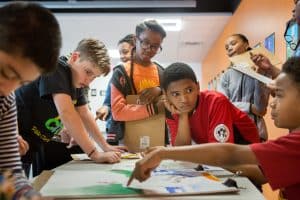Designing for Equity: Leveraging Competency-Based Education to Ensure All Students Succeed
CompetencyWorks Blog

Today, iNACOL and CompetencyWorks released Designing for Equity: Leveraging Competency-Based Education to Ensure All Students Succeed. With the help of Katherine Casey, we revised the earlier paper on equity developed for the 2017 National Summit on K-12 Competency-Based Education. Our thinking developed substantially based on the conversations at the Summit, and this paper will hopefully be of use to educators making the transition to competency education. Here are a couple of things I want to highlight:
1. We continue to find the definition from the National Educational Equity Project to be a powerful force in our thinking. It reminds us that challenging inequity requires a commitment to a vision, challenging institutional inequity, and taking responsibility for our own bias. (page 2-3)
2. We’ve become clearer about the flaws in the traditional system and have come to believe it is important to understand them so that you can see when these beliefs and practices are eating away at your introduction of personalized, competency-based practices and policies. (page 7-8)
3. We’ve identified ten distinguishing features of competency-based education. Much of this work was developed with the help of the Technical Advisory Group on creating a shared understanding of competency-based education. (page 11-12)
4. The nine principles of the equity framework are also found in the quality principles. We can’t underestimate the importance of understanding that quality and equity are essentially the same thing in a competency-based system that is designed to make sure every student is learning and getting the support they need to succeed. (page 14)
5. We developed the discussion on the principles to be used to guide discussion within districts and schools.
- Do NOT try to use them all at once. I think it is best to look at two or three of the principles together so that you can examine how they interact and reinforce each other.
- Look at one and identify examples in your schools or other schools you have visited. Then move to the next principle.
- Then look across them.
We are trying to build new systems, and that means integrating beliefs, policies, practices, and routines until they are so intertwined you can no longer pull them apart.
6. There are lots of people to thank. The participants in the Technical Advisory Group (TAG) on Equity and the Summit all contributed important concepts and guidance. Katherine Casey stepped up as a co-author on this paper and the other forthcoming papers on quality and logic models. Her knowledge and clarity is humbling, truly humbling. These partnership once more reminded me that complex problems need collaborative efforts. It’s just too much for any one brain to wrap itself around.
Thank you:
Technical Advisory Group on Equity: Denise Tobin Airola, Mandi Bozarth, Kelly Brady, Betsy Brand, Carisa Corrow, Randy DeHoff, Emily Dustin, Julia Freeland Fisher, Pat Fitzsimmons, Dan French, Laurie Gagnon, Liz Glowa, Brittany Griffin, Jill Gurtner, Thomas (T.J.) Jumper, Ian Kearns, Jeremy Kraushar, Susan Lanz, Steve Lavoie, Diana Lebeaux, Scott Marion, Mark Muenchau, Joy Nolan, Karla Esparza-Phillips, Aubrey Scheopner Torres, Matt Shea, Bob Sornson, Andresse St. Rose, Dale Skoreyko, Katherine Smith, Circe Stumbo, Barbara Treacy, C. Wesley Daniels, Karen White, Mike Wolking, Stacy Young, and Bill Zima.
Technical Advisory Group on Working Definition of Competency Education: Laureen Avery, Ana Botancourt, Michael Burde, Kim Carter, Katherine Casey, Cris Charbonneau, Rose Colby, Margaret Crespo, Cory Curl, Julia Freeland Fisher, Jenni Gotto, Virgel Hammonds, Christina Jean, Paul Leather, Amalia Lopez, Christy Kingham, Michael Martin, Adriana Martinez, Rebecca Midles, Rosmery Milczewski, Gretchen Morgan, James Murray, Joy Nolan, Jennifer Norford, Karla Phillips, Linda Pittenger, David Richards, Antonia Rudenstine, David Ruff, Sydney Schaef, Don Siviski, Brian Stack, David Richards, David Ruff, Megan Slocum, Wendy Surr, Cyndy Taymore, Eric Toshalis, Barbara Treacy, Claudette Trujillo, and Jonathan Vander Els.
National Summit Participants: Denise Airola, Amy Allen, Guadalupe Alvarez, Amy Anderson, Diego Arambula, Laureen Avery, Dixie Bacallao, John Bailey, Amy Barger, Susan Bell, Bryant Best, Mandi Bozarth, Kelly Brady, Yvonne Brandon, Rhonda Broussard, Trevor Brown, Mike Burde, Deb Bushway, Cris Charbonneau, Harvey Chism, Rose Colby, Brandon Corley, Margaret Crespo, Jenny Curtin, C. Wesley Daniel, Jon Deane, Sunny Deye, Elena Diaz-Bilello, Nicholas C. Donohue, Cederick Ellis, John Fischer, Amy Fowler, Julia Freeland Fisher, Tom Gaffey, Laurie Gagnon, Sajan George, Leah Hamilton, LeViis Haney, Karin Hess, Caroline Hill, Renee Hill, Rebecca Holmes, Christina Horner, Alison Hramiec, Amreena Hussain, Lindsay Jones, Christy Kingham, Jeremy Kraushar, Paul Leather, Tony Lewis, Chris Liang-Vergara, Phyllis Lockett, Alex Magaña, Scott Marion, Michael Martin, Adriana Martinez, Robert Marzano, Danny Medved, Rebecca Midles, Rosmery Milczewski, Tiffany Miller, Tony Monfiletto, Gretchen Morgan, Al Motley, Nikolaus Namba, Juan Carlos Oco’n, Eric Palleschi, Ace Parsi, Alphonso Paz, Doug Penn, Karla Esparza-Phillips, Linda Pittenger, David Richards, Tom Rooney, Antonia Rudenstine, David Ruff, Chris Rush, Kata Sandoval, Sydney Schaef, Don Siviski, Megan Slocum, Andresse St. Rose, Wendy Surr, Diane Tavenner, Cyndy Taymore, Alan Tenreiro, Saskia Thompson, Amy Torres, Eric Toshalis, Charline Toulmin, Donald Trujillo, Claudette Trujillo, Kendra Vair, Jonathan Vander Els, Matt Williams, and Bill Zima.